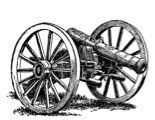
The house has gone through a number if expansions over the years. In 1926, when this property came into the possession of Robert C. and Frances H. Ligget and their children, Frances B. and Audrey H. Ligget, the house, now known as Stirling's Quarters, was in need of repairs but unspoiled architecturally and boasted no modern conveniences. Boyle Irwin was the architect, whose ability in renovation and adding an enlargement over the spring house in no way detracted from its original lines. SOURCE
William Alexander (aka Lord Stirling) (1726 New York City – 15 January 1783), who claimed the disputed title of Earl of Stirling, was an American major-general during the American Revolutionary War. When the American Revolutionary War began, Stirling was made a colonel in the New Jersey militia. He outfitted the militia at his own expense and was always willing to spend his own money in support of the cause. He distinguished himself early by leading a group of volunteers in the capture of an armed British transport. During the encampment at Valley Forge in late-1777 and early-1778, his headquarters was at the Maj. Gen. Lord Stirling Quarters. SOURCE
The structure also found its way onto a Wikipedia article. Maj. Gen. Lord Stirling Quarters, also known as Homestead Farm (1880) and Echo Valley Farms (1926-1973), is a historic home located in Tredyffrin Township, Chester County, Pennsylvania. The house was built in three sections, with the oldest dated to about 1738. The center structure is dated to 1769, and the kitchen added between 1791 and 1835. It is a stuccoed stone dwelling with a medium gable roof. The center section is three bays wide. It was renovated in 1926. During the American Revolution the house served as headquarters for Major General William Alexander, Lord Stirling in late-1777 and early-1778, during the encampment at Valley Forge. It was listed on the National Register of Historic Places in 1974. SOURCE
Speaking of the NRHP, the property is listed both as a contributing structure on the historic district inventory form as well as individually, with its own nomination form. There is a small barn and springhouse/kitchen with individual contributing listings. The following comes from the nomination form (citation below): The significance of Stirling's Quarters lies in its historical role in the American revolution as well as its study of early Pennsylvania farm life. The house was constructed in three sections. Tax records, wills, and deeds indicate buildings, gardens, and orchards were established prior to 1739. It is possible Henry John who purchased 100 acres in 1715 from the original tract of 1000, established the west section as a one story, one room structure. The center structure has been dated at 1769 and is credited to William Curie who purchased the farm in 1767. Thomas Walker who acquired the property in 1791 may have constructed the "new" kitchen mentioned in his will of 1835. I found a dated stone on the right corner of the property which has the initials and date, which reads W C 1869. There are a few other bricks with initials and dates, but I cannot figure out who those people were.
Naturally, a house this old and historical would be mentioned in the American Guide Series.
Right from the fork to STIRLING's HEADQUARTERS (private), 0.5 m., a compact two-story-and-attic white plastered stone farmhouse, built in three sections, with a small porch in front of the center section. Except for a recent addition in the rear, the building stands as built in 1769. ..... --- Pennsylvania: A Guide to the Keystone State, 1940; page 409
The house is located south of Valley Forge on Yellow Springs Road, on the left or north side of the road if traveling east. The house is diagonally across from Covered Bridge Road. There is a parking lot available on the left or west side of the house. I visited this house on March 19, 2011 @ 3:09 P.M., EDT, & @ an altitude of 247 feet ASL.
There is stone monument out front which reads:
Quarters Of
MAJ. GEN. WILLIAM ALEXANDER
LORD STERLING
Continental Army
During the Valley Forge
Encampment
December 19, 1777 - June 19, 1778
MAJ. JAMES MONROE
Fifth President of the United States
Also Quartered Here
As Aide-De-Camp to Stirling
Home of Parson William Currie
Erected by the PA.
Society Sons of the Revolution
December 19, 1975
Stirling's Quarters meets criterion A for its association with American Revolution and Criterion B for its association with George Washington and the impact of the encampment on his military career. PA SHPO concurrence 9/16/2004 to 2000 CLI that resource contributes to the national significance of Valley Forge NHP. The house is inventoried as structure no. 102.
From the Nomination Form:
William Currie's farmhouse served as Gen. William Alexander Lord Stirling's quarters, during winter Encampment of 1777-78. Listed as contributing in CLI, with SHPO concurrence on 09/16/2004.
Short Physical Description:
2-stories, 3 section hs, 20'x20'6", 21'6"x31'6", 18'x16', w/E section set back & ell extension at rear of W section which is joined by 1-1/2 story breezeway to spring house, 14'x23'.
Long Physical Description:
N/A

My Sources
1.
NRHP Nomination Form
2.
NRHP Nomination Form
3.
Historical Marker Database
4.
John Milner Architects, Inc.
5.
Wikipedia